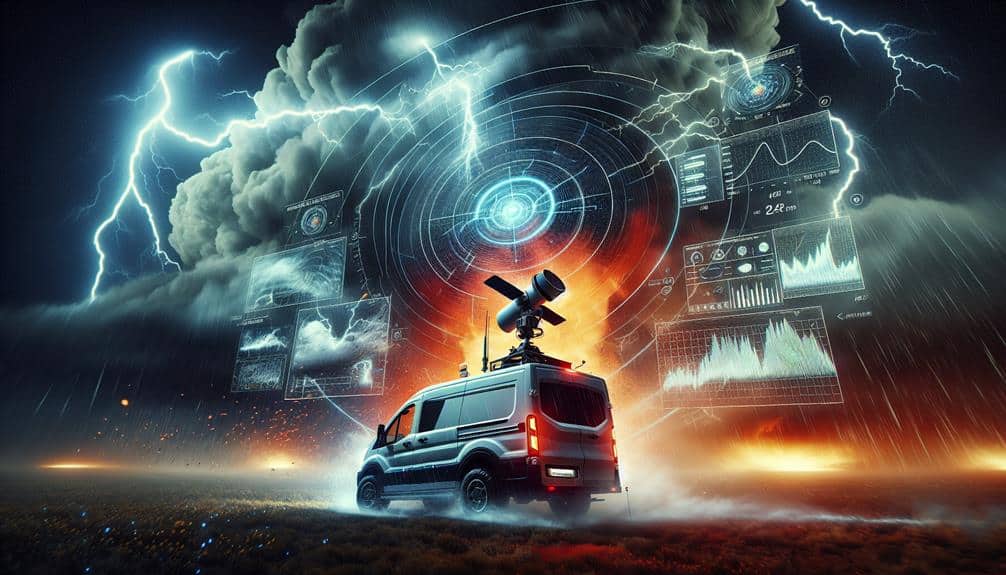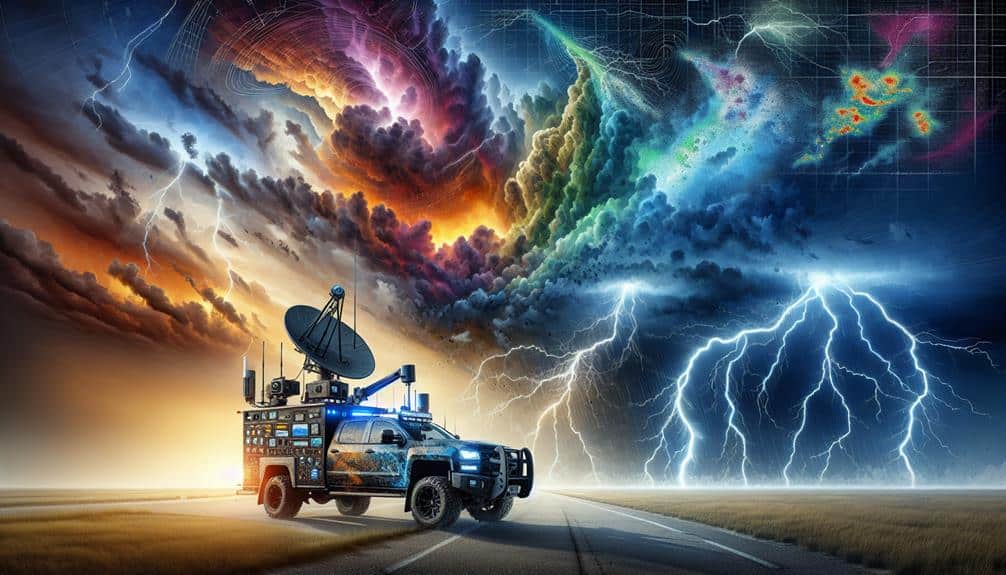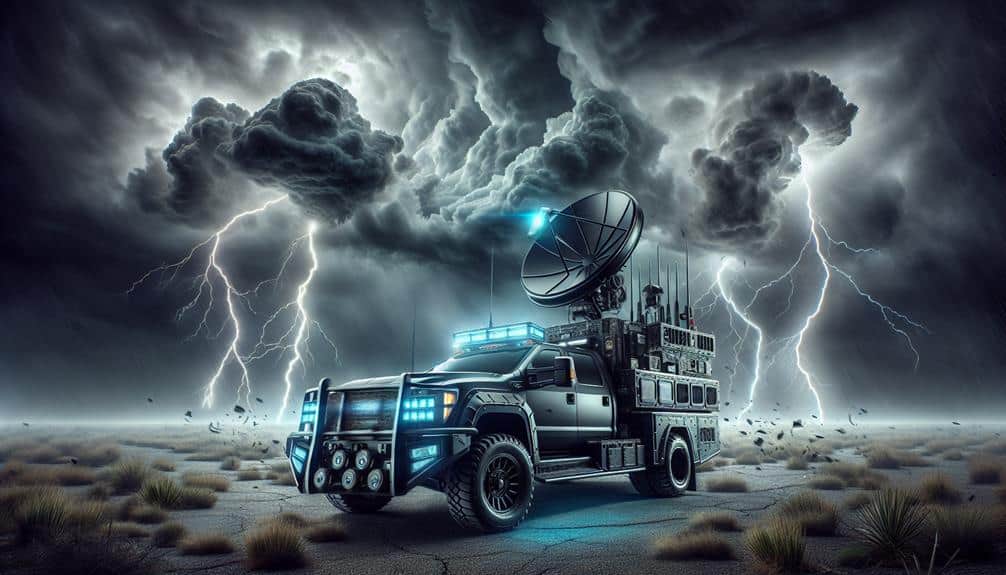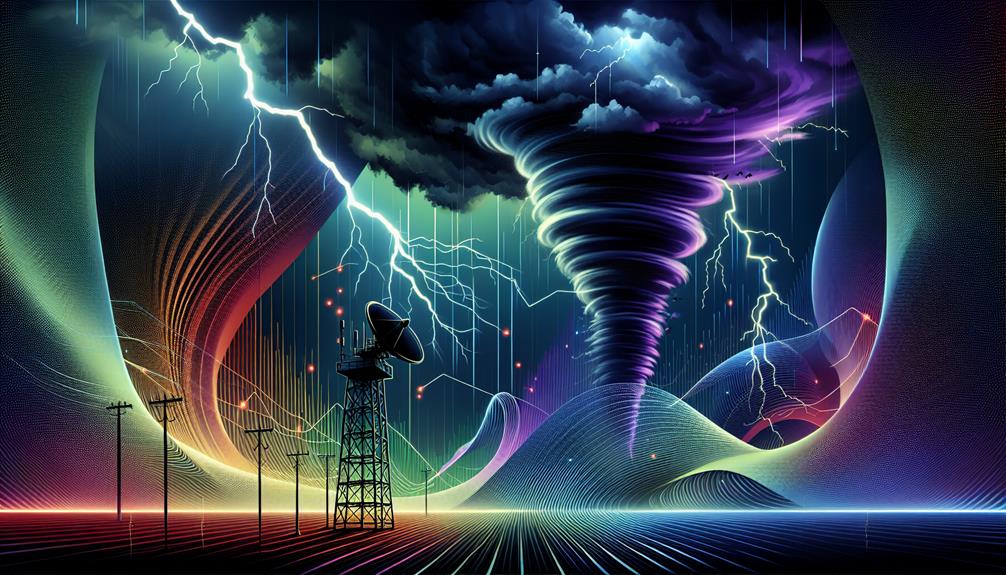We leverage Doppler radar for its real-time data precision, enabling accurate tracking and prediction of severe weather. Its advanced monitoring systems and visualization tools provide detailed insights into storm structures, wind speeds, and precipitation patterns. Early severe weather alerts improve our emergency response and public preparedness. Enhanced tracking capabilities deliver high-resolution updates on storm intensity and movement, ensuring safer and more efficient storm chasing. Improved safety measures arise from pinpointing storm locations and speeds, while better predictive analytics refine our forecasting accuracy through detailed data analysis. Explore further to discover how these benefits optimize storm chasing strategies.
Key Points
- Real-time data precision allows accurate tracking of severe weather events.
- Early severe weather alerts enhance preparedness and emergency response.
- High-resolution imaging provides detailed views of storm structures.
- Improved location accuracy enhances predictive storm path forecasts.
Real-Time Data Accuracy
Doppler radar provides us with real-time data precision that greatly enhances our ability to predict and track severe weather events. By leveraging advanced monitoring systems, we gain instant access to vital meteorological data. This allows us to visualize data in a way that reveals intricate details about storm structures, including wind speeds and precipitation patterns. Such accuracy is necessary for making informed decisions that can potentially save lives.
Our ability to employ Doppler radar's data visualization tools transforms raw data into comprehensible, actionable insights. These tools enable us to observe the dynamics of weather phenomena as they unfold, offering a clear picture of storm development and trajectory. The integration of monitoring systems ensures that we can assess these events in real-time, providing an unprecedented level of situational awareness.
We understand that timely and accurate information is essential for those of us seeking freedom from the unpredictable nature of severe weather. With Doppler radar, we can monitor storms continuously, guaranteeing that our data remains current and reliable. This empowers us to act decisively, whether we're planning evacuations, issuing warnings, or conducting research.
The real-time data precision of Doppler radar is vital for effective storm chasing and weather prediction.
Early Severe Weather Alerts
Building on the real-time data accuracy provided by Doppler radar, we gain the ability to issue early severe weather alerts, enhancing our preparedness and response efforts. These early alerts greatly improve our emergency response strategies, allowing us to mobilize resources and deploy personnel to critical areas before the storm impacts.
By accurately predicting severe weather events, Doppler radar empowers us to make informed decisions, reducing potential damage and loss of life.
Our ability to disseminate early warnings plays a pivotal role in increasing public awareness. When communities receive timely notifications about impending severe weather, they can take necessary precautions to protect themselves and their property. This proactive approach not only mitigates risks but also fosters a sense of security and freedom among the public, knowing they have the information needed to act swiftly.
Furthermore, early severe weather alerts enable us to coordinate with local authorities and emergency services more effectively. By sharing accurate Doppler radar data, we make sure that all parties are on the same page, optimizing the overall emergency response.
Essentially, the integration of Doppler radar in our operations enhances our capability to safeguard lives and property through timely, data-driven early warnings.
Enhanced Tracking Capabilities
The advanced tracking abilities provided by Doppler radar allow us to monitor storm development and movement with exceptional precision. By leveraging this advanced technology, we can pinpoint the exact location and trajectory of a storm, thereby enabling more accurate predictions. This level of location accuracy is essential for storm chasers who need to navigate safely and effectively while collecting data.
Doppler radar's advanced technology offers several key benefits:
- Real-time Data: We receive instant updates on storm intensity and movement, which allows us to make quick, informed decisions.
- Enhanced Resolution: The high-resolution imaging capabilities of Doppler radar give us a detailed view of storm structures, enabling better analysis of potential threats.
- Predictive Accuracy: With improved location accuracy, we can forecast storm paths more reliably, ensuring that we're always one step ahead.
- Layered Data: Doppler radar integrates multiple data layers, such as wind speed and precipitation levels, to provide a thorough understanding of storm dynamics.
Utilizing these capabilities, we can chase storms more efficiently and safely, maximizing our data collection efforts while minimizing risks. This is vital for those of us who chase storms not just for the thrill, but for the crucial research that contributes to public safety and scientific advancement.
Improved Safety Measures
By leveraging the precise data provided by Doppler radar, we can implement improved safety measures that reduce the risks associated with storm chasing to a great extent. The high-resolution data allows us to pinpoint the exact location, speed, and intensity of a storm, providing us with essential information for emergency response. This enables us to make informed decisions on when and where to chase, enhancing our overall risk mitigation strategies.
With Doppler radar, we can monitor real-time changes in storm structure, allowing us to anticipate sudden shifts in weather patterns. This capability is crucial for maintaining a safe distance from hazardous conditions, such as tornadoes or flash floods. It also aids in determining the safest escape routes, should the situation demand an immediate retreat.
Furthermore, Doppler radar enhances our communication with local authorities and emergency services. By sharing accurate and timely data, we help coordinate effective emergency response efforts. This not only guarantees our safety but also contributes to the broader community's well-being.
Better Predictive Analytics

Leveraging Doppler radar's capabilities not only enhances safety but also empowers us with advanced predictive analytics to forecast storm development with greater accuracy. By harnessing this technology, we can process real-time data to create precise models that predict weather patterns and potential storm paths. This is essential for making informed decisions and planning our storm-chasing strategies effectively.
Doppler radar enhances our predictive analytics in several significant ways:
- Improved Data Visualization: Doppler radar provides high-resolution images that allow us to visualize storm structures in detail. This enables us to identify key features such as mesocyclones and hook echoes, which are indicative of tornadic activity.
- Enhanced Forecast Accuracy: With Doppler radar, we can track wind speed and direction at various altitudes. This data improves our ability to forecast storm intensity and movement, reducing uncertainty in our predictions.
- Real-Time Data Analysis: Doppler radar continuously updates, offering us immediate insights into storm development. This real-time data is crucial for adjusting our forecasts and staying ahead of rapidly changing weather conditions.
- Historical Data Comparison: By comparing current data with historical radar records, we can identify patterns and trends, further refining our predictive models and enhancing forecast accuracy.
Incorporating these advanced analytics tools, we achieve greater freedom in our storm-chasing endeavors, knowing our predictions are backed by precise, real-time data.
Frequently Asked Questions
How Does Doppler Radar Differ From Traditional Radar Systems?
We use Doppler radar because it offers superior Doppler accuracy and storm prediction capabilities. Unlike traditional radar, Doppler radar enhances target detection and weather tracking, providing more precise data for forecasting severe weather events.
Can Doppler Radar Be Used in Non-Weather-Related Applications?
Yes, Doppler radar's versatile technology extends beyond weather forecasting. We can use it in industrial monitoring for machinery diagnostics and in traffic control systems to measure vehicle speeds, enhancing efficiency and safety in various non-weather-related applications.
How Costly Is It to Maintain Doppler Radar Equipment?
We should conduct a thorough cost analysis, considering regular calibration, software updates, and part replacements. Effective maintenance tips include routine inspections and timely repairs. Although maintenance can be costly, proper upkeep guarantees peak performance and data accuracy.
What Technological Advancements Have Improved Doppler Radar in Recent Years?
Imagine the thrill of precise storm tracking. In recent years, radar accuracy has surged thanks to enhanced Doppler capabilities, dual-polarization technology, and phased array systems. These advancements empower us with unprecedented storm prediction and tracking freedom.
How Do Storm Chasers Access Doppler Radar Data Remotely?
We access Doppler radar data remotely through advanced apps and software, enabling real-time data analysis and storm tracking. This technology empowers storm chasers to make informed decisions, enhancing safety and freedom in the field.


